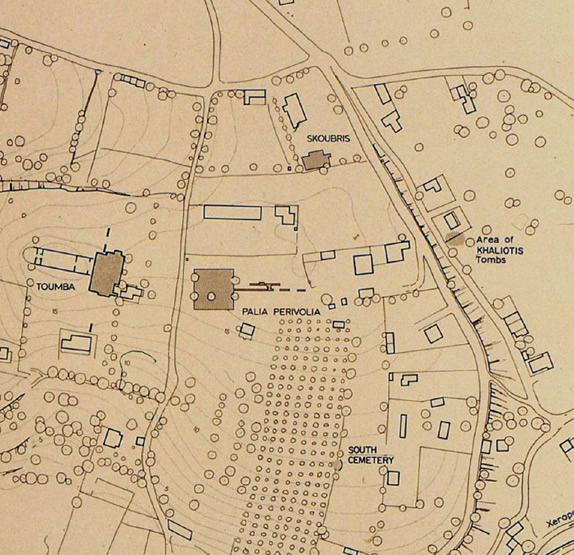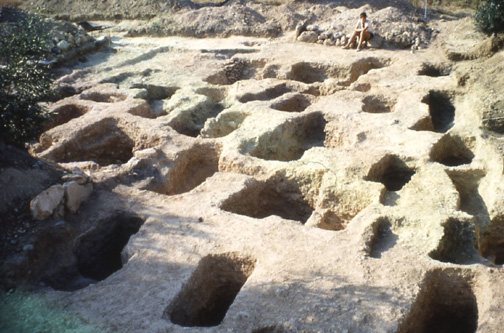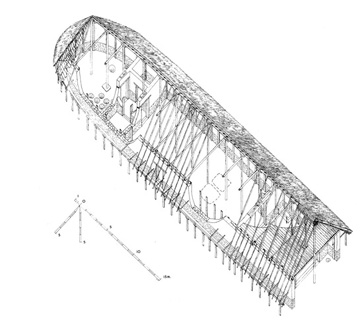
THE CEMETERIES
The cemeteries at Lefkandi are located on a low hill to the north of the modern harbour, at a distance of around 500 m from the ancient settlement on Xeropolis. Sadly, the Late Bronze Age cemetery has not been yet located.
 |
Map of Cemeteries |
In the area of the known cemeteries, at least six separate burial grounds
have been investigated, while there are strong indications that much of
the hillock was dedicated to burials. The earliest-known burials are located
to the north of the plot named Skoubris after its owner. In another plot
(in the field of Khaliotis), to the east, two robbed cist tombs belong
to an even earlier use of the area. The finds from these tombs are dated
to the late stage of Late Helladic (LH) IIIC. The burial ground of Palia
Perivolia was located some 100 m away from Skoubris. A trial trench to
the east of it revealed other burials which have been assigned to a separate
cemetery known as the ‘East Cemetery’. Further to the south,
the Greek Archaeological Service excavated a few burials belonging to
another burial plot, the ‘South Cemetery’. Only some 50 m
west of Palia Perivolia, on the eastern edge of an artificial mound (Toumba),
is located the Toumba Cemetery. This cemetery is immediately in front
of the east entrance of the Protogeometric building in which the two exceptional
Middle Protogeometric (MPG) burials were found. The total number of excavated
burials which have been published or reported from this area is 302.
 |
| Palia
Perivolia |
The only known Sub-Mycenaean (SM) and Early Protogeometric (EPG) burials
were found in the Skoubris cemetery, which continued to be used into the
Sub-Protogeometric (SPG) period. A total of sixty-four tombs were excavated
and twenty-one pyres but as the extent of the cemetery is unknown, more
graves must have initially been located in the area. According to the
excavators, most of the Palia Perivolia cemetery was completely excavated
and its boundaries defined, with forty tombs and forty-seven pyres recorded.
The earliest tomb is dated to the MPG period and the latest, as is the
case in the other burial plots at Lefkandi, to SPG III (late ninth century
BC). In the South Cemetery five burials – all inhumations –
and some pyres were found but their precise date has not been reported.
Finally, in the Toumba cemetery most of its area has been excavated including
eighty-three tombs and thirty-four pyres without counting the two burials
in the building (one inhumation and one cremation). The cemetery started
being used sometime in MPG, just after the filling-in of the building,
and stop receiving burials at the end of the SPG period.
Both inhumation and cremation were practiced but in most of the tombs
no traces of full inhumation or cremation were found. Two main types of
tombs were used, cists and shaft graves. Cist tombs were built in SM and
EPG and were then replaced by shaft graves from MPG onwards. A common
feature in all cemeteries is the use of ‘in situ’ cremations;
the pyres were usually built over large pits rectangular in shape. Urn
cremations are exceptional. The earliest example is that of the warrior
buried in the MPG building, whose remains were placed in a bronze amphora.
 |
Reconstruction
of Toumba Building |
The finds in the exceptional cemetery at Toumba leave no doubt that this was the burial ground of the ruling class of Lefkandi. There are many exceptionally rich graves containing a large number of local and imported vases, the latter usually from Athens and northern Greece. Weapons, jewellery and imports from the Near East and Egypt are also included in the grave offerings
Home > History of Research>Cemeteries>Toumba